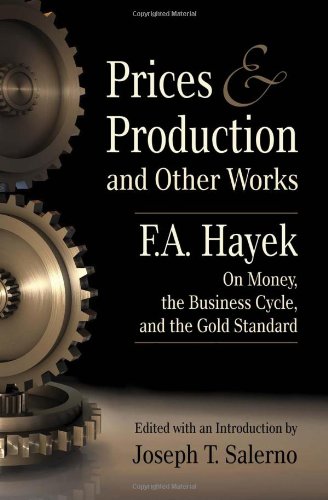
Prices and Production and Other Works on Money, the Business Cycle, and the Gold Standard PDF
594 Pages·2008·1.6052 MB·other
Most books are stored in the elastic cloud where traffic is expensive. For this reason, we have a limit on daily download.
Preview Prices and Production and Other Works on Money, the Business Cycle, and the Gold Standard
Description:
Hayek was not only a leading champion of liberty in the 20th century; as this massive book reveals, he was also a great economist whose elaboration on monetary theory and the business cycle made him the leading foe of Keynesian theory and policy in the English-speaking world.
The theory here is the subject of a massively popular video rap song — one which was oddly accurate! However, to truly understand the nuts and bolts, there is no substitute for Hayek's own works. Together they constitute a complete presentation of Hayekian money and business-cycle theory. Even more, they work together as an excellent elucidation of Austrian macroeconomic theory, which is why this book has already been adopted in some classrooms.
The timing could not be better. The entire world economy is now suffering from the effects of bad monetary policy, and with results that Hayek explains in great detail. With "countercyclical" policy again revealed as unworkable, and politicians plotting to make matters worse, the contents of this book have direct bearing on present and future monetary policy.
Hayek was barely out of his twenties in 1929 when he published the German versions of the first two works in this collection, Monetary Theory and the Trade Cycle and "The Paradox of Saving." The latter article was a long essay that was to become the core of his celebrated book and the third work in this volume, Prices and Production, the publication of which two years later made him a world-renowned economist by the age of thirty-two.
But the young Hayek did not pause to savor his success. He was already hard at work on "Reflections on the Pure Theory of Money of Mr. J.M. Keynes," a lengthy critical review of John Maynard Keynes's two-volume Treatise on Money, which had been published in 1930. Hayek's two-part review appeared in late 1931 and 1932.
There followed within a few years the other three works collected in this volume. "The Mythology of Capital" appeared in 1936 and was a response to Frank Knight's hostile criticisms of the Austrian theory of capital. A short article on "Investment That Raises the Demand for Capital" and the monograph "Monetary Nationalism and International Stability" were published in 1937.
These seven works taken together represent the first integration and systematic elaboration of the Austrian theories of money, capital, business cycles, and comparative monetary institutions, which constitute the essential core of Austrian macroeconomics.
These works have profoundly influenced postwar expositions of Austrian or capital-based macroeconomics down to the present day. The creation of such an oeuvre is a formidable intellectual feat over an entire lifetime; it is an absolute marvel when we consider that Hayek had completed it in the span of eight years (1929–1937) and still well shy of his fortieth birthday. Hayek's amazingly precocious intellect and creative genius are on full display in these works.
The theory here is the subject of a massively popular video rap song — one which was oddly accurate! However, to truly understand the nuts and bolts, there is no substitute for Hayek's own works. Together they constitute a complete presentation of Hayekian money and business-cycle theory. Even more, they work together as an excellent elucidation of Austrian macroeconomic theory, which is why this book has already been adopted in some classrooms.
The timing could not be better. The entire world economy is now suffering from the effects of bad monetary policy, and with results that Hayek explains in great detail. With "countercyclical" policy again revealed as unworkable, and politicians plotting to make matters worse, the contents of this book have direct bearing on present and future monetary policy.
Hayek was barely out of his twenties in 1929 when he published the German versions of the first two works in this collection, Monetary Theory and the Trade Cycle and "The Paradox of Saving." The latter article was a long essay that was to become the core of his celebrated book and the third work in this volume, Prices and Production, the publication of which two years later made him a world-renowned economist by the age of thirty-two.
But the young Hayek did not pause to savor his success. He was already hard at work on "Reflections on the Pure Theory of Money of Mr. J.M. Keynes," a lengthy critical review of John Maynard Keynes's two-volume Treatise on Money, which had been published in 1930. Hayek's two-part review appeared in late 1931 and 1932.
There followed within a few years the other three works collected in this volume. "The Mythology of Capital" appeared in 1936 and was a response to Frank Knight's hostile criticisms of the Austrian theory of capital. A short article on "Investment That Raises the Demand for Capital" and the monograph "Monetary Nationalism and International Stability" were published in 1937.
These seven works taken together represent the first integration and systematic elaboration of the Austrian theories of money, capital, business cycles, and comparative monetary institutions, which constitute the essential core of Austrian macroeconomics.
These works have profoundly influenced postwar expositions of Austrian or capital-based macroeconomics down to the present day. The creation of such an oeuvre is a formidable intellectual feat over an entire lifetime; it is an absolute marvel when we consider that Hayek had completed it in the span of eight years (1929–1937) and still well shy of his fortieth birthday. Hayek's amazingly precocious intellect and creative genius are on full display in these works.
See more
The list of books you might like
Most books are stored in the elastic cloud where traffic is expensive. For this reason, we have a limit on daily download.
